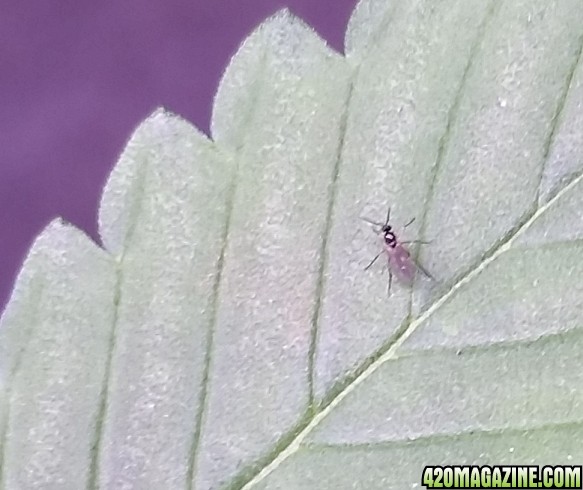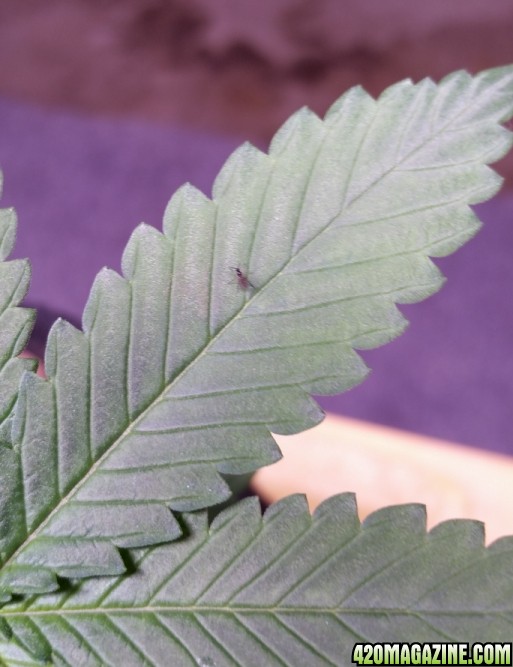Gnats are very tiny flying insects that can either be the kind that feed on roots or the kind that seek blood.
Either way, they are bothersome and can be harmful to your plants.
The larvae feed on the root systems, and if they are seedlings they can actually kill them due to the delicate nature of the roots and the minimal amount of root system developed.
I have a couple in the grow right now, and I have hung the sticky fly traps to trap the adults. It will not kill the larvae in the soil. That will take different measures as explained below.
I'll have some closer pictures soon:

As you can see, the adults are quite small and hard to see unless they are flying around you as you work.

The following information is from Orkin pest control site:
Gnats
Latin Name: Order Diptera
Several Families and Species
Appearance
Gnats typically are small and long-legged insects. They often are weak fliers.
Behavior, Diet & Habits
Gnat is the common name for many small, winged insects in the fly grouping. Contrary to popular belief, these tiny flying insects are not “babies,” they are adults. The tiny flying insects that many people call “gnats” could really be fruit flies or fungus gnats. Depending on species, gnats can be biting or nonbiting and will feed on plants, other insects or blood.
Reproduction
For some species, males assemble in large mating swarms known as ghosts. These swarms occur most commonly at dusk in large fields and above streets. Depending on the species, gnat eggs are laid on land or water. Larvae may be immobile or capable of movement by way of rocks and water plants. Adults range in size but usually are no larger than 33 mm. The larval and adult stages of the gnat are considered both beneficial and detrimental. Some species are excellent plant pollinators and feed on crop pests such as aphids and scales. Other gnats, such as the Hessian fly, are crop pests themselves.
Females of some species, such as the black gnat or black fly, feed on blood. These gnats have been known to carry parasites and spread diseases to humans and livestock. Due to the spread of river blindness and other health concerns, numerous programs have been established throughout the world to control gnat populations.
Signs of a Gnat Infestation
The main sign of gnats are the sightings of the adults as they fly about in the air.
Gnat Control
The best control for fungus gnats is to identify any plants that have wet soil and let that soil dry completely before the next watering. This will kill the larval stages in the soil. The adult gnats can be removed with a vacuum cleaner from windows and from around the plants.
For most gnat populations, their food source must be located and corrected if possible. Fruit should not be exposed to open air. Keeping fruit in the refrigerator protects it from gnats and also prolongs the fruit’s period of ripeness. Watering plants only when they need water will help prevent fungus gnat infestations.
Gnat Problems
While the small size of the gnat can make it appear less serious as a pest, it is important to remember that gnats reproduce quickly and populate infested areas in swarms. This is how gnats become larger problems to homeowners or apartment residents.
Fungus Gnats in House Plants:
Fungus gnats lay their eggs in damp soil of plants that have been overwatered. When the eggs hatch, the immature gnats feed on decomposing, organic material in the soil. These gnats are attracted to fungus that grows in the soil of houseplants that have been overwatered (by aaron at dh). Roots are commonly affected in areas infested by these gnats. Gnats feed on the roots and root hairs of plants, as well. They are most harmful to small plants, but can also destroy large plants if the plant is already unhealthy or if the gnat population is extremely large. Growers go to great lengths to prevent and eliminate gnat populations, as the damage caused by a gnat infestation can damage both ornamental and edible plants.
Fruit flies lay their eggs in fruit that is overripe or fermenting. They tend to hover near fruit as they are attracted to the scent and moisture of decaying, organic material. Fruit fly females lay their eggs in the fermenting fruit. The larvae eat the fruit when they hatch.
Either way, they are bothersome and can be harmful to your plants.
The larvae feed on the root systems, and if they are seedlings they can actually kill them due to the delicate nature of the roots and the minimal amount of root system developed.
I have a couple in the grow right now, and I have hung the sticky fly traps to trap the adults. It will not kill the larvae in the soil. That will take different measures as explained below.
I'll have some closer pictures soon:

As you can see, the adults are quite small and hard to see unless they are flying around you as you work.

The following information is from Orkin pest control site:
Gnats
Latin Name: Order Diptera
Several Families and Species
Appearance
Gnats typically are small and long-legged insects. They often are weak fliers.
Behavior, Diet & Habits
Gnat is the common name for many small, winged insects in the fly grouping. Contrary to popular belief, these tiny flying insects are not “babies,” they are adults. The tiny flying insects that many people call “gnats” could really be fruit flies or fungus gnats. Depending on species, gnats can be biting or nonbiting and will feed on plants, other insects or blood.
Reproduction
For some species, males assemble in large mating swarms known as ghosts. These swarms occur most commonly at dusk in large fields and above streets. Depending on the species, gnat eggs are laid on land or water. Larvae may be immobile or capable of movement by way of rocks and water plants. Adults range in size but usually are no larger than 33 mm. The larval and adult stages of the gnat are considered both beneficial and detrimental. Some species are excellent plant pollinators and feed on crop pests such as aphids and scales. Other gnats, such as the Hessian fly, are crop pests themselves.
Females of some species, such as the black gnat or black fly, feed on blood. These gnats have been known to carry parasites and spread diseases to humans and livestock. Due to the spread of river blindness and other health concerns, numerous programs have been established throughout the world to control gnat populations.
Signs of a Gnat Infestation
The main sign of gnats are the sightings of the adults as they fly about in the air.
Gnat Control
The best control for fungus gnats is to identify any plants that have wet soil and let that soil dry completely before the next watering. This will kill the larval stages in the soil. The adult gnats can be removed with a vacuum cleaner from windows and from around the plants.
For most gnat populations, their food source must be located and corrected if possible. Fruit should not be exposed to open air. Keeping fruit in the refrigerator protects it from gnats and also prolongs the fruit’s period of ripeness. Watering plants only when they need water will help prevent fungus gnat infestations.
Gnat Problems
While the small size of the gnat can make it appear less serious as a pest, it is important to remember that gnats reproduce quickly and populate infested areas in swarms. This is how gnats become larger problems to homeowners or apartment residents.
Fungus Gnats in House Plants:
Fungus gnats lay their eggs in damp soil of plants that have been overwatered. When the eggs hatch, the immature gnats feed on decomposing, organic material in the soil. These gnats are attracted to fungus that grows in the soil of houseplants that have been overwatered (by aaron at dh). Roots are commonly affected in areas infested by these gnats. Gnats feed on the roots and root hairs of plants, as well. They are most harmful to small plants, but can also destroy large plants if the plant is already unhealthy or if the gnat population is extremely large. Growers go to great lengths to prevent and eliminate gnat populations, as the damage caused by a gnat infestation can damage both ornamental and edible plants.
Fruit flies lay their eggs in fruit that is overripe or fermenting. They tend to hover near fruit as they are attracted to the scent and moisture of decaying, organic material. Fruit fly females lay their eggs in the fermenting fruit. The larvae eat the fruit when they hatch.


